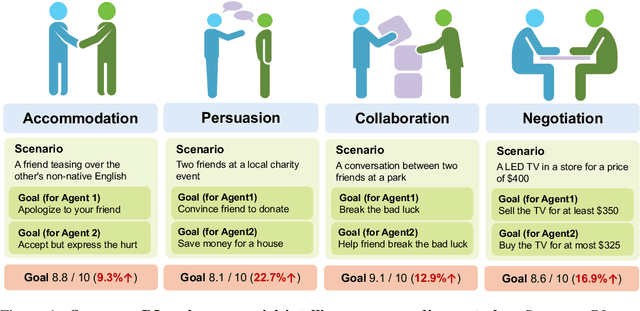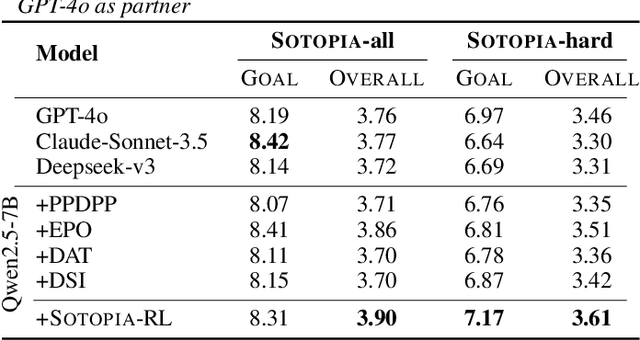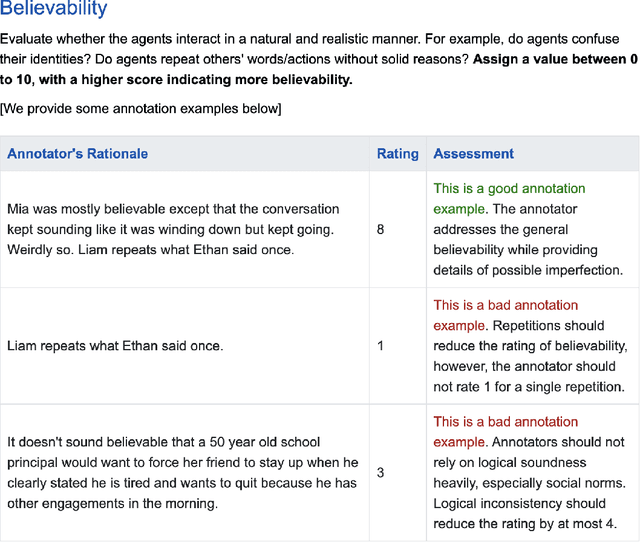Jiaxuan You
Sotopia-RL: Reward Design for Social Intelligence
Aug 05, 2025



Abstract:Social intelligence has become a critical capability for large language models (LLMs), enabling them to engage effectively in real-world social tasks such as accommodation, persuasion, collaboration, and negotiation. Reinforcement learning (RL) is a natural fit for training socially intelligent agents because it allows models to learn sophisticated strategies directly through social interactions. However, social interactions have two key characteristics that set barriers for RL training: (1) partial observability, where utterances have indirect and delayed effects that complicate credit assignment, and (2) multi-dimensionality, where behaviors such as rapport-building or knowledge-seeking contribute indirectly to goal achievement. These characteristics make Markov decision process (MDP)-based RL with single-dimensional episode-level rewards inefficient and unstable. To address these challenges, we propose Sotopia-RL, a novel framework that refines coarse episode-level feedback into utterance-level, multi-dimensional rewards. Utterance-level credit assignment mitigates partial observability by attributing outcomes to individual utterances, while multi-dimensional rewards capture the full richness of social interactions and reduce reward hacking. Experiments in Sotopia, an open-ended social learning environment, demonstrate that Sotopia-RL achieves state-of-the-art social goal completion scores (7.17 on Sotopia-hard and 8.31 on Sotopia-full), significantly outperforming existing approaches. Ablation studies confirm the necessity of both utterance-level credit assignment and multi-dimensional reward design for RL training. Our implementation is publicly available at: https://github.com/sotopia-lab/sotopia-rl.
ConsistencyChecker: Tree-based Evaluation of LLM Generalization Capabilities
Jun 14, 2025Abstract:Evaluating consistency in large language models (LLMs) is crucial for ensuring reliability, particularly in complex, multi-step interactions between humans and LLMs. Traditional self-consistency methods often miss subtle semantic changes in natural language and functional shifts in code or equations, which can accumulate over multiple transformations. To address this, we propose ConsistencyChecker, a tree-based evaluation framework designed to measure consistency through sequences of reversible transformations, including machine translation tasks and AI-assisted programming tasks. In our framework, nodes represent distinct text states, while edges correspond to pairs of inverse operations. Dynamic and LLM-generated benchmarks ensure a fair assessment of the model's generalization ability and eliminate benchmark leakage. Consistency is quantified based on similarity across different depths of the transformation tree. Experiments on eight models from various families and sizes show that ConsistencyChecker can distinguish the performance of different models. Notably, our consistency scores-computed entirely without using WMT paired data-correlate strongly (r > 0.7) with WMT 2024 auto-ranking, demonstrating the validity of our benchmark-free approach. Our implementation is available at: https://github.com/ulab-uiuc/consistencychecker.
Router-R1: Teaching LLMs Multi-Round Routing and Aggregation via Reinforcement Learning
Jun 10, 2025Abstract:The rapid emergence of diverse large language models (LLMs) has spurred the development of LLM routers that assign user queries to the most suitable model. However, existing LLM routers typically perform a single-round, one-to-one mapping (\textit{i.e.}, assigning each query to a single model in isolation), which limits their capability to tackle complex tasks that demand the complementary strengths of multiple LLMs. In this paper, we present \textbf{Router-R1}, a reinforcement learning (RL)-based framework that formulates multi-LLM routing and aggregation as a sequential decision process. Router-R1 instantiates the router itself as a capable LLM, leveraging its reasoning ability to interleave "think" actions (internal deliberation) with "route" actions (dynamic model invocation), and integrates each response into its evolving context. To guide learning, we employ a lightweight rule-based reward comprising format rewards, final outcome rewards, and a novel cost reward for performance and cost trade-off optimization, opening a pathway toward optimizing performance-cost tradeoffs via RL. Router-R1 also conditions only on simple model descriptors such as pricing, latency, and example performance, enabling strong generalization to unseen model selection. Experiments on seven general and multi-hop QA benchmarks show that Router-R1 outperforms over several strong baselines, achieving superior performance while maintaining robust generalization and cost management.Code is available at https://github.com/ulab-uiuc/Router-R1.
Beyond Facts: Evaluating Intent Hallucination in Large Language Models
Jun 06, 2025Abstract:When exposed to complex queries containing multiple conditions, today's large language models (LLMs) tend to produce responses that only partially satisfy the query while neglecting certain conditions. We therefore introduce the concept of Intent Hallucination. In this phenomenon, LLMs either omit (neglecting to address certain parts) or misinterpret (responding to invented query parts) elements of the given query, leading to intent hallucinated generation. To systematically evaluate intent hallucination, we introduce FAITHQA, a novel benchmark for intent hallucination that contains 20,068 problems, covering both query-only and retrieval-augmented generation (RAG) setups with varying topics and difficulty. FAITHQA is the first hallucination benchmark that goes beyond factual verification, tailored to identify the fundamental cause of intent hallucination. By evaluating various LLMs on FAITHQA, we find that (1) intent hallucination is a common issue even for state-of-the-art models, and (2) the phenomenon stems from omission or misinterpretation of LLMs. To facilitate future research, we introduce an automatic LLM generation evaluation metric, CONSTRAINT SCORE, for detecting intent hallucination. Human evaluation results demonstrate that CONSTRAINT SCORE is closer to human performance for intent hallucination compared to baselines.
* Accepted to ACL 2025 main conference
SafeScientist: Toward Risk-Aware Scientific Discoveries by LLM Agents
May 29, 2025Abstract:Recent advancements in large language model (LLM) agents have significantly accelerated scientific discovery automation, yet concurrently raised critical ethical and safety concerns. To systematically address these challenges, we introduce \textbf{SafeScientist}, an innovative AI scientist framework explicitly designed to enhance safety and ethical responsibility in AI-driven scientific exploration. SafeScientist proactively refuses ethically inappropriate or high-risk tasks and rigorously emphasizes safety throughout the research process. To achieve comprehensive safety oversight, we integrate multiple defensive mechanisms, including prompt monitoring, agent-collaboration monitoring, tool-use monitoring, and an ethical reviewer component. Complementing SafeScientist, we propose \textbf{SciSafetyBench}, a novel benchmark specifically designed to evaluate AI safety in scientific contexts, comprising 240 high-risk scientific tasks across 6 domains, alongside 30 specially designed scientific tools and 120 tool-related risk tasks. Extensive experiments demonstrate that SafeScientist significantly improves safety performance by 35\% compared to traditional AI scientist frameworks, without compromising scientific output quality. Additionally, we rigorously validate the robustness of our safety pipeline against diverse adversarial attack methods, further confirming the effectiveness of our integrated approach. The code and data will be available at https://github.com/ulab-uiuc/SafeScientist. \textcolor{red}{Warning: this paper contains example data that may be offensive or harmful.}
ToMAP: Training Opponent-Aware LLM Persuaders with Theory of Mind
May 29, 2025Abstract:Large language models (LLMs) have shown promising potential in persuasion, but existing works on training LLM persuaders are still preliminary. Notably, while humans are skilled in modeling their opponent's thoughts and opinions proactively and dynamically, current LLMs struggle with such Theory of Mind (ToM) reasoning, resulting in limited diversity and opponent awareness. To address this limitation, we introduce Theory of Mind Augmented Persuader (ToMAP), a novel approach for building more flexible persuader agents by incorporating two theory of mind modules that enhance the persuader's awareness and analysis of the opponent's mental state. Specifically, we begin by prompting the persuader to consider possible objections to the target central claim, and then use a text encoder paired with a trained MLP classifier to predict the opponent's current stance on these counterclaims. Our carefully designed reinforcement learning schema enables the persuader learns how to analyze opponent-related information and utilize it to generate more effective arguments. Experiments show that the ToMAP persuader, while containing only 3B parameters, outperforms much larger baselines, like GPT-4o, with a relative gain of 39.4% across multiple persuadee models and diverse corpora. Notably, ToMAP exhibits complex reasoning chains and reduced repetition during training, which leads to more diverse and effective arguments. The opponent-aware feature of ToMAP also makes it suitable for long conversations and enables it to employ more logical and opponent-aware strategies. These results underscore our method's effectiveness and highlight its potential for developing more persuasive language agents. Code is available at: https://github.com/ulab-uiuc/ToMAP.
Must Read: A Systematic Survey of Computational Persuasion
May 12, 2025Abstract:Persuasion is a fundamental aspect of communication, influencing decision-making across diverse contexts, from everyday conversations to high-stakes scenarios such as politics, marketing, and law. The rise of conversational AI systems has significantly expanded the scope of persuasion, introducing both opportunities and risks. AI-driven persuasion can be leveraged for beneficial applications, but also poses threats through manipulation and unethical influence. Moreover, AI systems are not only persuaders, but also susceptible to persuasion, making them vulnerable to adversarial attacks and bias reinforcement. Despite rapid advancements in AI-generated persuasive content, our understanding of what makes persuasion effective remains limited due to its inherently subjective and context-dependent nature. In this survey, we provide a comprehensive overview of computational persuasion, structured around three key perspectives: (1) AI as a Persuader, which explores AI-generated persuasive content and its applications; (2) AI as a Persuadee, which examines AI's susceptibility to influence and manipulation; and (3) AI as a Persuasion Judge, which analyzes AI's role in evaluating persuasive strategies, detecting manipulation, and ensuring ethical persuasion. We introduce a taxonomy for computational persuasion research and discuss key challenges, including evaluating persuasiveness, mitigating manipulative persuasion, and developing responsible AI-driven persuasive systems. Our survey outlines future research directions to enhance the safety, fairness, and effectiveness of AI-powered persuasion while addressing the risks posed by increasingly capable language models.
Nemotron-H: A Family of Accurate and Efficient Hybrid Mamba-Transformer Models
Apr 10, 2025Abstract:As inference-time scaling becomes critical for enhanced reasoning capabilities, it is increasingly becoming important to build models that are efficient to infer. We introduce Nemotron-H, a family of 8B and 56B/47B hybrid Mamba-Transformer models designed to reduce inference cost for a given accuracy level. To achieve this goal, we replace the majority of self-attention layers in the common Transformer model architecture with Mamba layers that perform constant computation and require constant memory per generated token. We show that Nemotron-H models offer either better or on-par accuracy compared to other similarly-sized state-of-the-art open-sourced Transformer models (e.g., Qwen-2.5-7B/72B and Llama-3.1-8B/70B), while being up to 3$\times$ faster at inference. To further increase inference speed and reduce the memory required at inference time, we created Nemotron-H-47B-Base from the 56B model using a new compression via pruning and distillation technique called MiniPuzzle. Nemotron-H-47B-Base achieves similar accuracy to the 56B model, but is 20% faster to infer. In addition, we introduce an FP8-based training recipe and show that it can achieve on par results with BF16-based training. This recipe is used to train the 56B model. All Nemotron-H models will be released, with support in Hugging Face, NeMo, and Megatron-LM.
Advances and Challenges in Foundation Agents: From Brain-Inspired Intelligence to Evolutionary, Collaborative, and Safe Systems
Mar 31, 2025Abstract:The advent of large language models (LLMs) has catalyzed a transformative shift in artificial intelligence, paving the way for advanced intelligent agents capable of sophisticated reasoning, robust perception, and versatile action across diverse domains. As these agents increasingly drive AI research and practical applications, their design, evaluation, and continuous improvement present intricate, multifaceted challenges. This survey provides a comprehensive overview, framing intelligent agents within a modular, brain-inspired architecture that integrates principles from cognitive science, neuroscience, and computational research. We structure our exploration into four interconnected parts. First, we delve into the modular foundation of intelligent agents, systematically mapping their cognitive, perceptual, and operational modules onto analogous human brain functionalities, and elucidating core components such as memory, world modeling, reward processing, and emotion-like systems. Second, we discuss self-enhancement and adaptive evolution mechanisms, exploring how agents autonomously refine their capabilities, adapt to dynamic environments, and achieve continual learning through automated optimization paradigms, including emerging AutoML and LLM-driven optimization strategies. Third, we examine collaborative and evolutionary multi-agent systems, investigating the collective intelligence emerging from agent interactions, cooperation, and societal structures, highlighting parallels to human social dynamics. Finally, we address the critical imperative of building safe, secure, and beneficial AI systems, emphasizing intrinsic and extrinsic security threats, ethical alignment, robustness, and practical mitigation strategies necessary for trustworthy real-world deployment.
GraphEval: A Lightweight Graph-Based LLM Framework for Idea Evaluation
Mar 16, 2025Abstract:The powerful capabilities of Large Language Models (LLMs) have led to their growing use in evaluating human-generated content, particularly in evaluating research ideas within academic settings. Existing solutions primarily rely on prompt-based LLM methods or fine-tuned lightweight language models for idea evaluation. However, these methods are often unstable and struggle to comprehend the complex semantic information embedded in the ideas, impeding their ability to perform high-quality evaluations. To address the above challenges, we propose GraphEval, a lightweight graph-based LLM framework for idea evaluation. Our insight is that a complex idea can be broken down into comprehensible viewpoint nodes using prompts from small LLMs. These viewpoint nodes can then be linked together through edges created from LLM-based relation extraction and/or BERT similarity scores. The created viewpoint-graph can be used to conveniently propagate scores across view-nodes to improve the robustness of the idea evaluations. In particular, we propose two lightweight graph-based methods for idea evaluation: (1) GraphEval-LP: a training-free label propagation algorithm that propagates evaluation scores from known view-nodes to unknown nodes; (2) GraphEval-GNN: a Graph Neural Networks (GNN) that is trained to predict the evaluation scores given the observed graph with minimal computation resources. Moreover, to overcome LLM's limitation in objectively assessing the novelty of ideas, we further propose a novelty detection model to GraphEval-GNN to enhance its capability in judging idea novelty. Experiments on two datasets show GraphEval improves F1 scores by at least 14% with low computation and API costs. Additionally, GraphEval can effectively detect plagiarized ideas.
 Add to Chrome
Add to Chrome Add to Firefox
Add to Firefox Add to Edge
Add to Edge